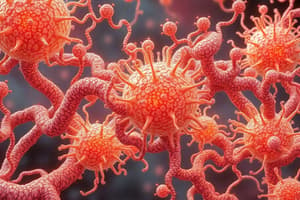Podcast
Questions and Answers
Robert Hooke discovered the cell in 1665.
Robert Hooke discovered the cell in 1665.
True (A)
According to the cell theory, all organisms are composed of molecules.
According to the cell theory, all organisms are composed of molecules.
False (B)
Unicellular organisms are capable of independent existence and carry out functions like digestion and reproduction.
Unicellular organisms are capable of independent existence and carry out functions like digestion and reproduction.
True (A)
Human blood contains about five billion erythrocytes per cubic ml of blood.
Human blood contains about five billion erythrocytes per cubic ml of blood.
Muscle cells are mainly concerned with the conduction of nerve impulses.
Muscle cells are mainly concerned with the conduction of nerve impulses.
Prokaryotic cells have a nucleus and membrane-bound organelles.
Prokaryotic cells have a nucleus and membrane-bound organelles.
The majority of cells are visible to the naked eye.
The majority of cells are visible to the naked eye.
Both bacteria and archaea belong to the prokaryotic domain.
Both bacteria and archaea belong to the prokaryotic domain.
Eukaryotic cells lack nuclei and membrane-bound organelles.
Eukaryotic cells lack nuclei and membrane-bound organelles.
Human red blood cells measure 7-8 mm in diameter.
Human red blood cells measure 7-8 mm in diameter.




